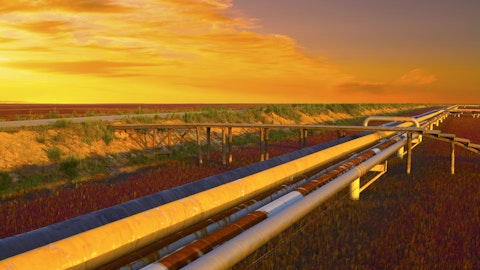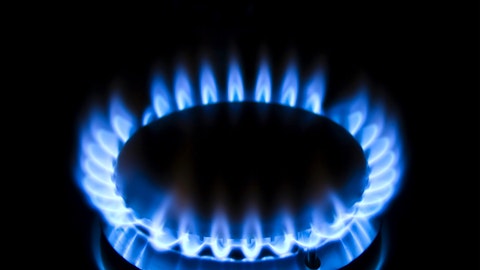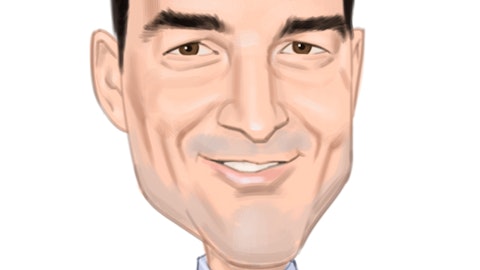PG&E Corporation (NYSE:PCG) Q2 2023 Earnings Call Transcript July 27, 2023
PG&E Corporation misses on earnings expectations. Reported EPS is $0.25 EPS, expectations were $0.28.
Operator: Ladies and gentlemen thank you for standing by. My name is Brent and I will be your conference operator today. At this time, I would like to welcome everyone to the PG&E Corporation Second Quarter 2023 Earnings Release Call. [Operator Instructions] It is now my pleasure to turn today’s call over to Mr. Jonathan Arnold Vice President of Investor Relations. Please go ahead.
Jonathan Arnold: Good morning everyone and thank you for joining us for PG&E’s Second Quarter 2023 Earnings Call. With us today are Patti Poppe, Chief Executive Officer; and Carolyn Burke, Executive Vice President and Chief Financial Officer. We also have other members of the leadership team here with us in our Oakland headquarters. First, I should remind you that today’s discussion will include forward-looking statements about our outlook for future financial results. These statements are based on information currently available to management. Some of the important factors which could affect our actual financial results are described on the second page of today’s second quarter earnings call presentation. Presentation also includes a reconciliation between non-GAAP and GAAP financial measures.
The slides along with other relevant information can be found online at investor.pgecorp.com. We would also encourage you to review our quarterly report on Form 10-Q for the quarter ended June 30 2023. With that it’s my pleasure to hand the call over to our CEO Patti Poppe.
Patti Poppe: Thank you, Jonathan. And good morning, everyone. Thanks for joining us on what we know is a very busy earnings morning. We continue to make progress here at PG&E and this quarter is no different. Our core earnings per share of $0.23 for the second quarter bring us to $0.52 for the first half of 2023. While our first half earnings are down $0.03 versus 2022 we have not yet recognized the benefit of our general rate case. As a reminder we have a memo account in place which will allow us to book catch-up revenues from the January 1 2023 effective date once we receive a final CPUC decision. We still expect a final decision in the third quarter and we were encouraged that the CPUC affirmed this timing earlier this month.
As we shared at our Investor Day in May 86% of our incremental revenue request is for core safety reliability and maintenance work. All areas where there is strong alignment with state policy goals and stakeholder priorities. While the GRC decision will be an important driver halfway through the year we remain on track to plan and laser-focused on delivering our annual guidance which we are reaffirming today. We are also reaffirming earnings growth rates of at least 10% in 2024 and at least 9% in 2025 and 2026 along with our commitment to no new equity issuance through 2024. Turning to Slide 4. We’ve continued to make progress in mitigating physical and financial risk. On the physical front we continue to focus on system resilience by reducing wildfire risk and preparing for the grid of the future.
We continue to make progress on the regulatory front as well. For example, in the second quarter the CPUC approved over $1 billion of interim rate relief in our 2022 Wednesday proceeding. This accelerates the time line for recovering our legacy wildfire mitigation spend improves our financial metrics and allows us to deliver on needed safety reliability and customer connections work benefiting both our customers and our investors. On the legal front, at the end of May, we were pleased to settle with the Shasta County District Attorney’s Office resolving the criminal charges related to the 2020 Zogg Fire. The settlement includes commitments by PG&E to contribute $45 million to various local organizations as part of our ongoing efforts to make it right and make it safe.
Our settlement followed rulings by the Superior Court which upheld our long-standing position that there was no evidence showing PG&E’s inspections fell below the required standard of care, nor was there any evidence that the risk related to the tree was visible prior to the fire. The court’s ruling from April is available on our Investor Relations website. Turning to financial risk mitigation. Our strategy continues to hinge around the simple affordable model, which delivers consistently improving value for customers and investors. Regarding the Fire Victim Trust, we are encouraged that the trust has now monetized over 85% of its initial holding and at steadily higher values for its beneficiaries. After the 60 million share sale earlier this month, the trust now holds just over 3% of our stock.
As of the end of June, determination notices have been issued for 97% of all claims with the trustee having indicated a goal to reach 100% and monetize the remaining shares by year-end. Turning to slide five. We highlight our layers of protection strategy along with our anticipated step-up in risk reduction from 90% to 94%, as we roll out our new and expanded programs under our 2023 Wildfire Mitigation Plan. One example is downed conductor detection technology, which involves installing new hardware in the field, supplementing our enhanced power line safety settings. We filed our WMP with the Office of Energy Infrastructure Safety in late March and the OEIS came out with its revision notice towards the end of June. We view this feedback as a constructive part of the WMP process and we embrace the opportunity to drive further alignment with our regulators.
OEIS identified eight critical issues and we will file our response by August 7 deadline with the draft decision from OEIS expected at the end of September. The revision notice process will not preclude us from filing our annual safety certificate application by the due date of September 13 with OEIS approval due 90 days later. As a reminder, our existing safety certificate remains in effect pending an OEIS decision on our timely filed new application. Earlier this month, at the Annual Board level safety briefing with the CPUC, our Utility Board Chair, Cheryl Campbell; and our Chief Operating Officer, Sumeet Singh discussed our safety culture, performance and details of our enterprise safety management system. These meetings are an element of our AB 1054 compliance and provide an opportunity to engage with regulators on our improvement strategies.
We were encouraged to hear commissioners recognize our significant progress, while acknowledging our challenges including changing climate conditions. It’s in moments like this that we step back and reflect on the progress being made. In fact at a recent meeting with all of our top leaders, Mark Quinlan, our SVP of Wildfire and Emergency Operations stood up to address the elephant in the room when he said, I bet you’re all watching the weather and thinking back to 2017. Well, let me remind you just how much we’ve done since then. He went on to remind us all that we have an entirely different readiness posture and physical risk mitigation regime in place. Back in 2017, we were reacting and responding to hazards. The investments we’ve made since then have enabled a dramatic shift to predicting and preventing.
Slide 6 illustrates the mitigations now in place thanks to these important investments in innovation. To name just a few. Since 2017, we have installed over 600 high-definition cameras now with AI capabilities more than 1,400 weather stations and almost 1,400 sectionalizing devices. We’ve hardened over 1,300 miles of line and undergrounded over 300 more. We’ve removed 3.3 million trees. We’ve staffed a hazard awareness warning center 24 hours a day seven days a week 365 days a year and we’ve hired 130 fire prevention professionals who are on our PG&E team and making us safer every day. We’ve implemented a host of operational mitigations including enhanced power line safety settings on 44000 miles of line in and adjacent to our high fire risk areas.
We’ve enabled public safety power shutoffs when conditions warrant them and new for 2023 we’ve deployed partial voltage force out and down conductor detection. Our system has never been safer and yet it will be even safer still tomorrow and every day after that. As we shared with the CPUC during the safety briefing we are making progress and we have more work to do. Safety permeates through everything we do and the presence of controls, including our layers of protection leads to manageable and predictable outcomes. I’m confident that we and our key partners including the state are doing everything we can to cause our stance catastrophic wildfires shall stop. The data tell the story. Through mid-July reportable ignitions in our high fire threat district have decreased 53% from the equivalent date in 2017.
Last year, we saw a 68% reduction in ignitions on EPSS-enabled circuits and a 99% reduction in acres burned. The data so far suggests we are on track to see further improvement in 2023. Our hard work over the past five years has dramatically changed our risk exposure and the fundamental safety of our system and we aren’t stopping there. Moving to slide 7. We also see profound changes in financial risk mitigation due to the framework put in place by SB 901 and AB 1054. At our Investor Day, you heard Ann Patterson Governor Newsom’s Cabinet Secretary talk about how the state Wildfire Fund is working as planned. The AB 1054 construct is designed to give utilities and capital providers the financial assurance they need while deploying the investments required to bring down wildfire risk on the system over time.
Let me quickly revisit the key features for those looking for a refresher or who may be newer to our story. For wildfire claims exceeding $1 billion in a calendar year, we have access to the state wildfire fund. This provides $21 billion of claim-paying capacity protecting investors from the risk of a liquidity event. Our annual wildfire mitigation plan is a requirement for receiving our annual safety certificate. So long as we have a valid safety certificate we have access to two additional key features of AB 1054. First, the utility’s conduct is presumed to have been prudent upfront when it comes to seeking cost recovery at the CPUC along with the prudency standard modeled on the constructive FERC precedent. Second in the unlikely event of the utility being found to have acted imprudently any resulting obligation to reimburse the wildfire fund would be capped at 20% of electric T&D equity rate base on a three-year rolling basis.
This cap is currently around $3 billion for PG&E. This is a much better construct than what was in place prior to SB 901 and AB 1054 and that enables the attraction of the necessary capital to build and operate a safe and climate resilient energy system. Turning to Slide 8. Let’s review our regulatory and legislative time line. We’ve made progress on multiple fronts in the first half of the year including, approval of our wildfire self-insurance settlement, the Zogg Fire litigation settlement and 2022 WMCE Interim Rate release. Looking forward, we have several catalysts on the horizon, starting with a GRC final decision expected in the current quarter; the ongoing legislative session in Sacramento where we have seen constructive engagement on energization, which you’ve heard us previously refer to as new customer connections, showing the legislature’s commitment to California’s clean energy transition and then on our 2023 wildfire mitigation plan and safety certification processes.
Looking a little further out, at the end of this year, we will file our nuclear operating license extension application for Diablo Canyon with NRC and we remain ready to submit our 10-year undergrounding plan once the OEIS and the CPUC complete their scoping process. On Slide 9, you have our 2023 report card where we’re showing on track for each of our 2023 and long-term targets. This includes our plan to underground 350 miles in 2023, double last year’s target and our 2024 FFO to debt target of mid-teens. As you can see, we’re also projecting on track for our 2% non-fuel O&M reduction target, which brings me to my story of the month. This month’s story illustrates how our regional service model together with our performance playbook and lean operating system is helping improve the customer experience while we eliminate waste and cost in our work processes.
In the North Coast region field operations teams are improving upon a common sense approach that has worked in a lot of our programs bundling work. What’s different now is that the teams are working across various branches of electric gas systems inspections and vegetation management to coordinate many types of work, not just bundling similar work in siloed programs as we’ve done in the past. Cross-functional work bundling allows crews to do more work under the same planned outage line clearance, reducing the cost of switching and grid operations and improving overall reliability. During Q2, my coworkers planned and executed 12 jobs under just one planned outage near the town of Willits. Rather than impacting 100-plus customers multiple times over the year, we did it all in just one go.
That’s one outage, one day of traffic lane closures, one batch of notifications and only one visit. This goes to show you what’s possible when we put the customer at the center of our operations. So far this year, we estimate savings of $0.5 million and 800-plus hours when we did not have to deenergize our customers. This is just the tip of the iceberg and something we are working actively to scale up across all regions, proving we can deliver an improved customer experience while cutting costs all at the same time. This is all part of the momentum we’re building here at PG&E. And with that, I’ll turn it over to Carolyn.
Carolyn Burke: Thank you, Patti, and good morning everybody. As Patti mentioned, we are on track to deliver our 2023 financial commitments. Today, we are reaffirming EPS growth of at least 10% each year in 2023 and 2024 and at least 9% in 2025 and 2026. We’re also reaffirming our commitment to no new equity in 2023 or 2024. This morning, I’ll cover three main topics with you: our 2023 results, the simple affordable model and our value proposition. Let’s start on Slide 10. We are on track to meet our 2023 EPS guidance of $1.19 to $1.23. Our first half results and drivers of our forecast for the second half of 2023 are presented here. On a year-to-date basis our result is $0.52 per share, including $0.23 in the second quarter.
Our first half EPS is on plan. And as Patti mentioned our plan to reduce non-fuel O&M by 2% is also on track. So far this year we’ve realized $0.04 of favorability from our cost-saving efforts and we’ve redeployed $0.02 right back into the business. Although our year-to-date result is down $0.03 compared to 2022, a key driver for the second half of 2023 will be a final decision in our GRC. As a reminder the CPUC has approved a standard memo account, which allows us to record catch-up revenues back to January 1st once the final decision is received. This explains the $0.01 of timing as shown here and also why you don’t see customer capital investment as a growth driver in our first half results. Finally, we’re showing $0.04 of other. This is a combination of many smaller items over the first and second quarters including higher property taxes reflecting our increased customer capital investment.
On Slide 11 our capital investment plans have not changed from Investor Day when we provided insight into our 10-year plan. Our 9.5% rate based CAGR reflects the abundant opportunities to invest capital into our system for the benefit of customers. Please recall this is a no big bets approach focused on safety and reliability with growth benefiting both our customers and our investors. Just as our earnings grow with capital growth it’s worth repeating that this capital investment growth above depreciation also provides additional cash flow to help internally fund the investment. Moving to slide 12. We continue to see ample opportunities to expand customer investment beyond the $52 billion planned through 2027. We are fortunate to have substantial needs for investment in our electric distribution and transmission systems as well as opportunities to further improve quality and reduce cost.
Our simple affordable model is at the heart of our plan. It is how we plan to keep bills affordable for our customers, which takes us to Slide 13. As you’ve seen we revisit this slide with you each quarter providing proof points on our execution. Patti already provided an update on our O&M cost reduction progress. And now I’m excited to share some recent efficient financing developments. Our minority sale of non-nuclear generating assets or Pacific Gen continues to move through the regulatory process. We launched the marketing for the proposed sale last month. We expect these attractive and differentiated assets to draw strong investor interest as they are fully regulated with a favorable ratemaking framework. And with California’s environmental policies in place, we see a very supportive backdrop for growth opportunities.
As a reminder the Pac Gen regulatory and sales processes will progress unparallel time lines. Additionally last month we submitted a loan application to the Department of Energy under the Energy Infrastructure reinvestment program. Our application is all about enabling California’s clean energy transition. If our application is approved, we would expect to draw down these funds starting in 2024 and through 2026 to align with spending in our GRC cycle. This is another example of how we’re pursuing efficient financing to deliver for our customers and our communities at a lower cost. In addition to providing a diversified funding source for our large capital program, lower cost DOE loans could result in hundreds of millions of dollars in interest expense savings for our customers over the life of the loans.
This means that our planned rate base growth could come at a lower cost for our customers creating more capacity for investment in customer benefiting infrastructure, definitely a win-win. We plan to submit part two of our application in the coming months in which we will work with the loan program office on the technical and financial evaluation of our application. I’ll end here on slide 14 with a reiteration of dividend timing. Specifically, we expect to reach a cumulative $6.2 billion in non-GAAP core earnings since our emergence from Chapter 11 during the third quarter. As we have said before, this timing remains subject to assumptions including the timing of major regulatory decisions. In practice, this means that our Board could have the opportunity to declare a dividend as soon as our third quarter earnings call.
We are committed to restoring a dividend and recognize its importance to traditional utility investors. But let me be clear, we plan to recommend to the Board that we start out with a small dividend likely lower than some published estimates. This will allow us to continue prioritizing needed capital investment including safety and physical risk reduction on behalf of our customers. While we would expect to grow our dividend at least in line with earnings per share, our initial bias will be towards premium EPS growth versus higher yield consistent with our capital investment priority. Our physical and financial risks are being mitigated. Our capital investment need and growth forecast benefits customers and investors. Our EPS growth is among the very best as our stock price recovers from a deep discount.
And our value proposition is strong and improving every quarter. And with that I’ll hand it back to Patti.
Patti Poppe: Thank you, Carolyn. Before we take your questions, I wanted to take a quick moment to highlight two other pieces of news from PG&E this week. Yesterday, we issued our annual corporate sustainability report which outlines major strides we’ve made towards the triple bottom-line of serving people the planet and California’s prosperity. Using statistics and stories the report details meaningful action we took last year in service of our home towns throughout Northern and Central California. Second as highlighted here on slide 15 we hosted our inaugural Innovation Summit earlier this week drawing over 2,000 in-person and virtual participants from venture capital, technolog, academic and financial world. Risk mitigation in particular wildfire has rightly been Job one and our main priority.
At the same time, our California service area is at the very forefront of the energy transition given our state’s bold vision for the future. With this in mind, we created our innovation research and development team to capitalize on breakthrough opportunities drawing on the external innovation ecosystem to inspire bold new ideas for safety and our operations. For example, during the Innovation Summit, we featured a first-of-its-kind version of Schneider’s electric distribution energy management system operating on the Microsoft Cloud. On the topic of innovation, I’m also pleased to announce that the XPrize competition featured at our Investor Day has already received interest from 120 individual teams out of 32 different countries. Talk about breakthrough opportunities.
The objective of this competition is to be able to pinpoint ignitions from space within 60 seconds or less and autonomously suppress wildfires within 10 minutes. I’m excited to see what these brilliant minds produce. I’ll wrap up on Slide 16, by saying we feel good about the progress we are making, mitigating physical and financial risk. We’re confident in the protections we have in place for this wildfire season. And we see several catalysts ahead for investors including restoration of our common stock dividend and a final decision in our 2023 GRC. We see the progress and feel the momentum. We hope you do too. With that operator, please open up the line for questions.
See also 25 Most Addictive Video Games in the World and 20 Best AI Chrome Extensions for 2023.
Q&A Session
Follow Pg&E Corp (NYSE:PCG)
Follow Pg&E Corp (NYSE:PCG)
Operator: [Operator Instructions] Your first question is from the line of Shar Pourreza with Guggenheim. Your line is open.
Shar Pourreza: Hey, guys. Good morning.
Patti Poppe: Good morning, Shar.
Shar Pourreza: Good morning. Patti I just wanted to start off with a question on the GRC timing. It seems there’s obviously some filing still happening. They’re coming through and the PD still isn’t issued as you kind of highlighted there. I guess, what’s your level of confidence here in getting a PD and what is a potential delay in the PD due as we’re thinking about disclosures and when you recognize earnings and update guidance including obviously, enactment of official dividend policy? Thanks.
Patti Poppe: Okay, Shar. Thank you for that’s a very robust question. I’m going to get right at it. First let me remind you that our GRC is 85% safety, reliability, resilience work. Our customers are demanding this work of us and our stakeholders are really supportive of us doing this work. So I think that bodes very well for our GRC and its outcome. It’s important that we remain aligned with our regulators to deliver on a very important regulatory outcome that is so important and so good for customers. So I’ll just start with that. But just – I’ll just back up and remind you about the timing. So the CPUC voted to extend the GRC deadline from June 30 to December 30. They needed that calendar so that the final decision could be issued still in Q3, which they have been pretty clear that it was going to be issued in Q3.
So while the CPUC hasn’t issued their proposed decision, the July 13 order included language that reinforced the timing. The commission, in fact the quote is that the commission still anticipates consideration of this matter on a commission agenda in the third quarter of 2023. We were very grateful for that reiteration of the importance of the timing. I think it’s been really clear. We’ve been working closely with our stakeholders here in the state, how important it is that we get a timely GRC sold that. We can do this very important necessary work for our customers. So all that to say, obviously, we plan conservatively on the expected outcomes and we’ve got a plan that we think is defendable and is going to be welcomed by the commission but we’re also putting in our contingency planning to make sure we’re ready.
Now I’ll just close out with your final question about the implications for the dividend. I think Carolyn was very clear in our prepared remarks about the importance of the dividend, why we know that it’s important to establish a dividend. But what’s most important is that we’re doing the right work for customers and we’ve got the GRC is obviously, the most important that we have a good GRC outcome. Now we’re in the final stages of that GRC process. We’ve said that the dividend is dependent on regulatory timing, and I don’t want to get ahead of ourselves at all here. We’re going to watch how that plays out, and then we’ll give an update and let you know the status on the third quarter call.
Shar Pourreza: Perfect. Fantastic. And then just lastly for me, Patti. Just maybe briefly touching on sort of your expectations for safety certification and the WMP approvals. I mean OEIS and the stakeholders still kind of scrutinize the details of the plan. Are there concerns, that caused you to engage remediating action? Or is that already in plan? And how is the time line shifting as the WMP moves towards PD and you plan to file the 23 certification in September. Thanks.






